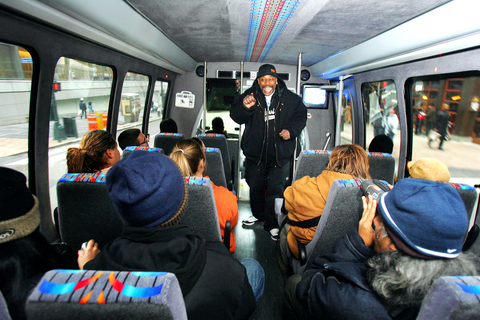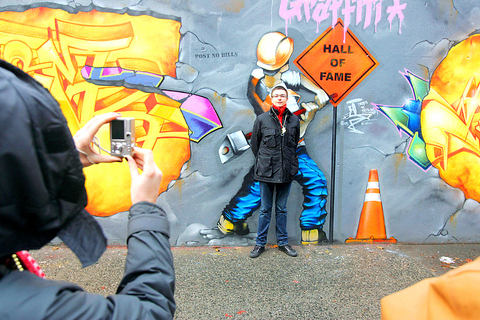Just before noon on a raw, wet Saturday a few weeks ago, two dozen tourists piled off of a bus at Frederick Douglass Boulevard and 155th Street in Harlem and made their way into Rucker Park. The park is a Harlem landmark, the site of the annual Entertainer's Basketball Classic, a summer tournament that pits local legends against professional players. But the tour group was there for a different kind of performance.
In the otherwise empty park, they were greeted by Wonder Rock and Mouse, two break dancers from Brooklyn, who hooked up an MP3 player to a Pignose portable amplifier, blasted a James Brown breakbeat, and were soon moving across the rain-slickened asphalt, demonstrating moves like the toprock, the coffee grinder and the windmill. When the show was over, the audience was invited to clamber down from the bleachers for a quick tutorial. A paunchy, 40-ish white guy from Dallas announced that he had been in a break dance crew a couple of decades earlier, and was soon down on the ground, executing a better-than-passable windmill.
That elicited whoops from the tour guide, a burly 45-year-old named Curtis Fisher, better known as Grandmaster Caz. Caz is a renowned figure in early hip hop, a member of the venerated Bronx rap crew the Cold Crush Brothers and the ghostwriter of some famous verses of Rapper's Delight, the 1979 Sugarhill Gang song that became rap's breakthrough single.

PHOTOS: NY TIMES
Today, he has gone from making history to teaching it. Caz is one of several hip-hop pioneers -- including Kurtis Blow, Doug E. Fresh and DJ Red Alert -- who work for Hush Tours (www.hushtours.com), a Manhattan company that since June 2002 has run hip-hop-centric sightseeing tours of Harlem and the Bronx.
The success of Hush Tours is a sign that hip hop has become part of New York's official cultural heritage -- for younger visitors especially, a tourist magnet right up there with the Brooklyn Bridge or the Statue of Liberty.
But Hush Tours offers something more than just sightseeing: an argument about authenticity, an opportunity, in the words of its promotional literature, to "see, hear and feel the true meaning of the elements of hip hop." In so doing, the tour reflects debates about history, memory and "the real hip hop" that have become more pronounced and contentious as the years have passed and hip-hop culture has developed a self-consciousness about its past.

As Hush Tours takes pains to point out, hip-hop history stretches back to the early 1970s, years before the first rap records were even recorded. "This is the 32nd year of the culture of hip hop," said Caz, as the bus rolled north on Madison Avenue, adding, with an MC's flair for self-mythology, "This is my 33rd year in the game."
Hush Tours is the brainchild of a 38-year-old Bronx native, Debra Harris. Several years ago, Harris, a legal secretary, began taking members of her family on impromptu driving tours to places like the former site of Harlem World Entertainment Complex on 116th Street, where rival rap crews had faced off in rhyme battles a quarter-century ago. Harris was motivated, she said, by a desire to pass along knowledge of hip hop's roots to her children. She soon realized that she had stumbled on an untapped tourist market.
"When you go to Nashville, you know that's the home of country music," Harris said. "New York needed to step up to the plate, to say officially that this is the birthplace of hip hop. The city was sleeping on it. I discovered that younger visitors who loved rap music were eager for more knowledge, for a different kind of tourist experience that would get them out of Times Square."
Today, for US$70, the Hush Tours bus whisks visitors to the Grand Concourse in the Bronx, making stops at, among other places, the Graffiti Hall of Fame at 106th Street and Park Avenue, a schoolyard featuring enormous murals by some of the city's top graffiti artists, and Bobby's Happy House, a record store owned by Bobby Robinson, the onetime proprietor of Enjoy Records, which released some of the earliest hip hop singles.
The real action, though, takes place on the bus, where the tour guides play music, reminisce, instruct and proselytize. "This is an opportunity to pass on the truth," said the rapper Kurtis Blow, who is also host of Backspin, a Sirius Satellite Radio program devoted to old-school hip hop. "Hip-hop history has been lied about, distorted and in some cases outright destroyed."
Leading bus tours is not exactly the standard afterlife for onetime stars like Blow, whose 1980 single The Breaks was the first rap record to go gold. But the pioneers of hip hop regard the tours as a way to ensure their legacies.
Red Alert, a longtime fixture on the New York airwaves, said: "It's great because we didn't have a platform to pass on our knowledge. The tour has given us a platform to explain the history that we experienced, the history that we set in motion."
On that chilly Saturday a few weeks back, Caz was a jovial, blunt tour guide. "Today you're going to learn what hip hop is and what it's not," he announced at the tour's outset. "It's not just rap music, and it's definitely not just the 10 records you hear over and over again on the radio."
He peppered his talk with oft-told hip-hop tales and intriguing nuggets of cultural history. He told hip hop's creation story, of the famous 1973 party in the Bronx, at 1520 Sedgwick Avenue in Morris Heights, whose host was the legendary Jamaican immigrant disc jockey, DJ Kool Herc. He described how the looting of hi-fi stores during the 1977 New York City blackout propelled DJ culture. ("It was like Christmas for black people" he said. "The next day there were a thousand new DJs.")
He played charmingly primitive early rap records, like the Fatback Band's King Tim III (Personality Jock)(widely regarded as the genre's first single) and songs by the Sequence, one of the earliest all-female rap ensembles. He waxed rhapsodic over hip hop's humble beginnings, when the biggest rap shows in New York were announced on hand-lettered Xeroxed fliers (Caz distributed several vintage examples), and DJs powered their sound systems for outdoor block parties by tapping into the wiring of street lamps.
"The rappers today who can drive around in Bentleys, with their jewelry and million-dollar homes," Caz told the tour group. "They're able to live like that because cats like me and Bambaataa" -- the famous rapper and DJ Afrika Bambaataa -- "were in the trenches back in the day, laying the groundwork and getting chased off the block by the police."

May 11 to May 18 The original Taichung Railway Station was long thought to have been completely razed. Opening on May 15, 1905, the one-story wooden structure soon outgrew its purpose and was replaced in 1917 by a grandiose, Western-style station. During construction on the third-generation station in 2017, workers discovered the service pit for the original station’s locomotive depot. A year later, a small wooden building on site was determined by historians to be the first stationmaster’s office, built around 1908. With these findings, the Taichung Railway Station Cultural Park now boasts that it has

The latest Formosa poll released at the end of last month shows confidence in President William Lai (賴清德) plunged 8.1 percent, while satisfaction with the Lai administration fared worse with a drop of 8.5 percent. Those lacking confidence in Lai jumped by 6 percent and dissatisfaction in his administration spiked up 6.7 percent. Confidence in Lai is still strong at 48.6 percent, compared to 43 percent lacking confidence — but this is his worst result overall since he took office. For the first time, dissatisfaction with his administration surpassed satisfaction, 47.3 to 47.1 percent. Though statistically a tie, for most

Wooden houses wedged between concrete, crumbling brick facades with roofs gaping to the sky, and tiled art deco buildings down narrow alleyways: Taichung Central District’s (中區) aging architecture reveals both the allure and reality of the old downtown. From Indigenous settlement to capital under Qing Dynasty rule through to Japanese colonization, Taichung’s Central District holds a long and layered history. The bygone beauty of its streets once earned it the nickname “Little Kyoto.” Since the late eighties, however, the shifting of economic and government centers westward signaled a gradual decline in the area’s evolving fortunes. With the regeneration of the once

In February of this year the Taipei Times reported on the visit of Lienchiang County Commissioner Wang Chung-ming (王忠銘) of the Chinese Nationalist Party (KMT) and a delegation to a lantern festival in Fuzhou’s Mawei District in Fujian Province. “Today, Mawei and Matsu jointly marked the lantern festival,” Wang was quoted as saying, adding that both sides “being of one people,” is a cause for joy. Wang was passing around a common claim of officials of the People’s Republic of China (PRC) and the PRC’s allies and supporters in Taiwan — KMT and the Taiwan People’s Party — and elsewhere: Taiwan and